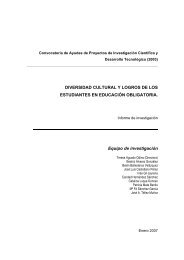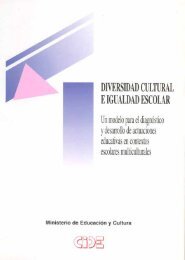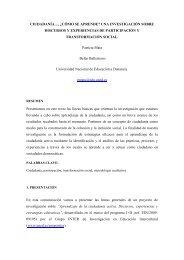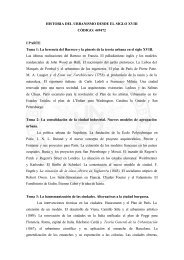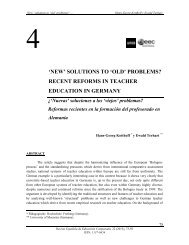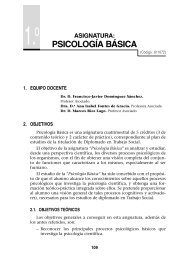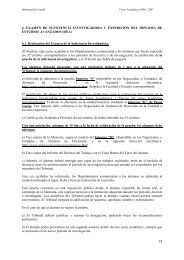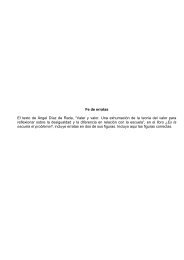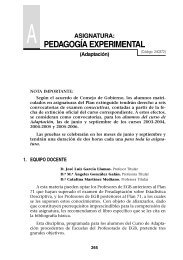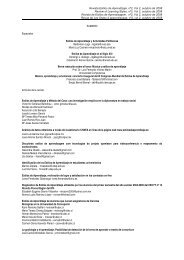- Page 1:
MODELADO DE SISTEMAS MEDIANTE DEVS
- Page 4 and 5:
MODELADO DE SISTEMAS MEDIANTE DEVS
- Page 6 and 7:
MODELADO DE SISTEMAS MEDIANTE DEVS
- Page 8 and 9:
MODELADO DE SISTEMAS MEDIANTE DEVS
- Page 11:
OBJETIVOS DOCENTES Una vez estudiad
- Page 14 and 15:
MODELADO DE SISTEMAS MEDIANTE DEVS
- Page 16 and 17: MODELADO DE SISTEMAS MEDIANTE DEVS
- Page 18 and 19: MODELADO DE SISTEMAS MEDIANTE DEVS
- Page 20 and 21: MODELADO DE SISTEMAS MEDIANTE DEVS
- Page 22 and 23: MODELADO DE SISTEMAS MEDIANTE DEVS
- Page 24 and 25: MODELADO DE SISTEMAS MEDIANTE DEVS
- Page 26 and 27: MODELADO DE SISTEMAS MEDIANTE DEVS
- Page 28 and 29: MODELADO DE SISTEMAS MEDIANTE DEVS
- Page 30 and 31: MODELADO DE SISTEMAS MEDIANTE DEVS
- Page 32 and 33: MODELADO DE SISTEMAS MEDIANTE DEVS
- Page 34 and 35: MODELADO DE SISTEMAS MEDIANTE DEVS
- Page 36 and 37: MODELADO DE SISTEMAS MEDIANTE DEVS
- Page 38 and 39: MODELADO DE SISTEMAS MEDIANTE DEVS
- Page 40 and 41: MODELADO DE SISTEMAS MEDIANTE DEVS
- Page 42 and 43: MODELADO DE SISTEMAS MEDIANTE DEVS
- Page 44 and 45: MODELADO DE SISTEMAS MEDIANTE DEVS
- Page 46 and 47: MODELADO DE SISTEMAS MEDIANTE DEVS
- Page 48 and 49: MODELADO DE SISTEMAS MEDIANTE DEVS
- Page 51: OBJETIVOS DOCENTES Una vez estudiad
- Page 54 and 55: MODELADO DE SISTEMAS MEDIANTE DEVS
- Page 56 and 57: MODELADO DE SISTEMAS MEDIANTE DEVS
- Page 58 and 59: MODELADO DE SISTEMAS MEDIANTE DEVS
- Page 60 and 61: MODELADO DE SISTEMAS MEDIANTE DEVS
- Page 62 and 63: MODELADO DE SISTEMAS MEDIANTE DEVS
- Page 64 and 65: MODELADO DE SISTEMAS MEDIANTE DEVS
- Page 68 and 69: MODELADO DE SISTEMAS MEDIANTE DEVS
- Page 70 and 71: MODELADO DE SISTEMAS MEDIANTE DEVS
- Page 72 and 73: MODELADO DE SISTEMAS MEDIANTE DEVS
- Page 74 and 75: MODELADO DE SISTEMAS MEDIANTE DEVS
- Page 76 and 77: MODELADO DE SISTEMAS MEDIANTE DEVS
- Page 78 and 79: MODELADO DE SISTEMAS MEDIANTE DEVS
- Page 80 and 81: MODELADO DE SISTEMAS MEDIANTE DEVS
- Page 82 and 83: MODELADO DE SISTEMAS MEDIANTE DEVS
- Page 84 and 85: MODELADO DE SISTEMAS MEDIANTE DEVS
- Page 86 and 87: MODELADO DE SISTEMAS MEDIANTE DEVS
- Page 88 and 89: MODELADO DE SISTEMAS MEDIANTE DEVS
- Page 90 and 91: MODELADO DE SISTEMAS MEDIANTE DEVS
- Page 92 and 93: MODELADO DE SISTEMAS MEDIANTE DEVS
- Page 94 and 95: MODELADO DE SISTEMAS MEDIANTE DEVS
- Page 96 and 97: MODELADO DE SISTEMAS MEDIANTE DEVS
- Page 98 and 99: MODELADO DE SISTEMAS MEDIANTE DEVS
- Page 100 and 101: MODELADO DE SISTEMAS MEDIANTE DEVS
- Page 102 and 103: MODELADO DE SISTEMAS MEDIANTE DEVS
- Page 104 and 105: MODELADO DE SISTEMAS MEDIANTE DEVS
- Page 106 and 107: MODELADO DE SISTEMAS MEDIANTE DEVS
- Page 108 and 109: MODELADO DE SISTEMAS MEDIANTE DEVS
- Page 110 and 111: MODELADO DE SISTEMAS MEDIANTE DEVS
- Page 112 and 113: MODELADO DE SISTEMAS MEDIANTE DEVS
- Page 114 and 115: MODELADO DE SISTEMAS MEDIANTE DEVS
- Page 116 and 117:
MODELADO DE SISTEMAS MEDIANTE DEVS
- Page 118 and 119:
MODELADO DE SISTEMAS MEDIANTE DEVS
- Page 120 and 121:
MODELADO DE SISTEMAS MEDIANTE DEVS
- Page 123:
3.1. Introducción 3.2. Modelos DEV
- Page 127 and 128:
3.1. INTRODUCCI ÓN DEVS CL ÁSICO
- Page 129 and 130:
ta : S → R + 0,∞ DEVS CL ÁSICO
- Page 131 and 132:
¦ §¨ ( = δ ) ( ) ¤ ©
- Page 133 and 134:
X = R Y = R S = {“pasivo”} δex
- Page 135 and 136:
DEVS CL ÁSICO “responde”, el s
- Page 137 and 138:
DEVS CL ÁSICO X = R Y = R S = {“
- Page 139 and 140:
S = {“pasivo”,“activo”} ×
- Page 141 and 142:
DEVS CL ÁSICO en consecuencia, el
- Page 143 and 144:
donde: X = R Y = R S = {“pasivo
- Page 145 and 146:
DEVS CL ÁSICO X = { (p, v) | p ∈
- Page 147 and 148:
DEVS CL ÁSICO por el producto cart
- Page 149 and 150:
DEVS CL ÁSICO como el modelo compu
- Page 151 and 152:
3.4.1. Modelo de una secuencia de e
- Page 153 and 154:
DEVS CL ÁSICO Las conexiones trans
- Page 155 and 156:
DEVS CL ÁSICO D = {s0, p0, p1} Con
- Page 157 and 158:
3.5.2. Intercambio de mensajes DEVS
- Page 159 and 160:
DEVS CL ÁSICO Variables: parent //
- Page 161 and 162:
when ( recibe mensaje-* (*,t) en el
- Page 163 and 164:
DEVS CL ÁSICO un algoritmo Devs-co
- Page 165 and 166:
- Un mensaje-i de inicialización,
- Page 167 and 168:
ecibe tn_d* de d* actualiza la list
- Page 169 and 170:
DEVS CL ÁSICO para la ejecución d
- Page 171 and 172:
t // Reloj de la simulación hijo /
- Page 173 and 174:
DEVS CL ÁSICO Qd = { (sd, ed) | sd
- Page 175 and 176:
DEVS CL ÁSICO El conjunto de estad
- Page 177 and 178:
DEVS CL ÁSICO El tiempo hasta la s
- Page 179 and 180:
¥¦§¨ © A B δ ( ) = A
- Page 181 and 182:
DEVS CL ÁSICO entrada X1. En la Fi
- Page 183 and 184:
Ejercicio 3.7 DEVS CL ÁSICO Descri
- Page 185 and 186:
3.8. SOLUCIONES A LOS EJERCICIOS So
- Page 187 and 188:
©¤¤¦¡¢©¢ ¡¢£¤¥¦§¡
- Page 189 and 190:
donde: DEVS CL ÁSICO DEVS = 〈X,
- Page 191 and 192:
DEVS CL ÁSICO y que representa el
- Page 193 and 194:
DEVS CL ÁSICO Los eventos de entra
- Page 195 and 196:
donde: DEVS CL ÁSICO - La variable
- Page 197:
El comportamiento del sistema puede
- Page 201:
OBJETIVOS DOCENTES Una vez estudiad
- Page 204 and 205:
MODELADO DE SISTEMAS MEDIANTE DEVS
- Page 206 and 207:
MODELADO DE SISTEMAS MEDIANTE DEVS
- Page 208 and 209:
MODELADO DE SISTEMAS MEDIANTE DEVS
- Page 210 and 211:
MODELADO DE SISTEMAS MEDIANTE DEVS
- Page 212 and 213:
MODELADO DE SISTEMAS MEDIANTE DEVS
- Page 214 and 215:
MODELADO DE SISTEMAS MEDIANTE DEVS
- Page 216 and 217:
MODELADO DE SISTEMAS MEDIANTE DEVS
- Page 218 and 219:
MODELADO DE SISTEMAS MEDIANTE DEVS
- Page 220 and 221:
MODELADO DE SISTEMAS MEDIANTE DEVS
- Page 222 and 223:
MODELADO DE SISTEMAS MEDIANTE DEVS
- Page 224 and 225:
MODELADO DE SISTEMAS MEDIANTE DEVS
- Page 226 and 227:
MODELADO DE SISTEMAS MEDIANTE DEVS
- Page 228 and 229:
MODELADO DE SISTEMAS MEDIANTE DEVS
- Page 231:
OBJETIVOS DOCENTES Una vez estudiad
- Page 234 and 235:
MODELADO DE SISTEMAS MEDIANTE DEVS
- Page 236 and 237:
MODELADO DE SISTEMAS MEDIANTE DEVS
- Page 238 and 239:
MODELADO DE SISTEMAS MEDIANTE DEVS
- Page 240 and 241:
MODELADO DE SISTEMAS MEDIANTE DEVS
- Page 242 and 243:
MODELADO DE SISTEMAS MEDIANTE DEVS
- Page 244 and 245:
MODELADO DE SISTEMAS MEDIANTE DEVS
- Page 246 and 247:
MODELADO DE SISTEMAS MEDIANTE DEVS
- Page 248 and 249:
MODELADO DE SISTEMAS MEDIANTE DEVS
- Page 250 and 251:
MODELADO DE SISTEMAS MEDIANTE DEVS
- Page 252 and 253:
MODELADO DE SISTEMAS MEDIANTE DEVS
- Page 254 and 255:
MODELADO DE SISTEMAS MEDIANTE DEVS
- Page 256 and 257:
MODELADO DE SISTEMAS MEDIANTE DEVS
- Page 258 and 259:
MODELADO DE SISTEMAS MEDIANTE DEVS
- Page 260 and 261:
MODELADO DE SISTEMAS MEDIANTE DEVS
- Page 262 and 263:
MODELADO DE SISTEMAS MEDIANTE DEVS
- Page 264 and 265:
MODELADO DE SISTEMAS MEDIANTE DEVS
- Page 266 and 267:
MODELADO DE SISTEMAS MEDIANTE DEVS
- Page 268 and 269:
MODELADO DE SISTEMAS MEDIANTE DEVS
- Page 271:
OBJETIVOS DOCENTES Una vez estudiad
- Page 274 and 275:
MODELADO DE SISTEMAS MEDIANTE DEVS
- Page 276 and 277:
MODELADO DE SISTEMAS MEDIANTE DEVS
- Page 278 and 279:
MODELADO DE SISTEMAS MEDIANTE DEVS
- Page 280 and 281:
MODELADO DE SISTEMAS MEDIANTE DEVS
- Page 282 and 283:
MODELADO DE SISTEMAS MEDIANTE DEVS
- Page 284 and 285:
MODELADO DE SISTEMAS MEDIANTE DEVS
- Page 286 and 287:
MODELADO DE SISTEMAS MEDIANTE DEVS
- Page 288 and 289:
MODELADO DE SISTEMAS MEDIANTE DEVS
- Page 290 and 291:
MODELADO DE SISTEMAS MEDIANTE DEVS
- Page 292 and 293:
MODELADO DE SISTEMAS MEDIANTE DEVS
- Page 294 and 295:
MODELADO DE SISTEMAS MEDIANTE DEVS
- Page 296 and 297:
MODELADO DE SISTEMAS MEDIANTE DEVS
- Page 298 and 299:
MODELADO DE SISTEMAS MEDIANTE DEVS
- Page 300 and 301:
MODELADO DE SISTEMAS MEDIANTE DEVS
- Page 302 and 303:
MODELADO DE SISTEMAS MEDIANTE DEVS
- Page 304 and 305:
MODELADO DE SISTEMAS MEDIANTE DEVS
- Page 306 and 307:
MODELADO DE SISTEMAS MEDIANTE DEVS
- Page 308 and 309:
MODELADO DE SISTEMAS MEDIANTE DEVS
- Page 310 and 311:
MODELADO DE SISTEMAS MEDIANTE DEVS
- Page 312 and 313:
MODELADO DE SISTEMAS MEDIANTE DEVS
- Page 314 and 315:
MODELADO DE SISTEMAS MEDIANTE DEVS
- Page 316 and 317:
MODELADO DE SISTEMAS MEDIANTE DEVS
- Page 318 and 319:
MODELADO DE SISTEMAS MEDIANTE DEVS
- Page 320 and 321:
MODELADO DE SISTEMAS MEDIANTE DEVS
- Page 322 and 323:
MODELADO DE SISTEMAS MEDIANTE DEVS
- Page 324 and 325:
acoplamiento modular, 27 no modular
- Page 326 and 327:
MODELADO DE SISTEMAS MEDIANTE DEVS
- Page 328 and 329:
MODELADO DE SISTEMAS MEDIANTE DEVS
- Page 330:
MODELADO DE SISTEMAS MEDIANTE DEVS




